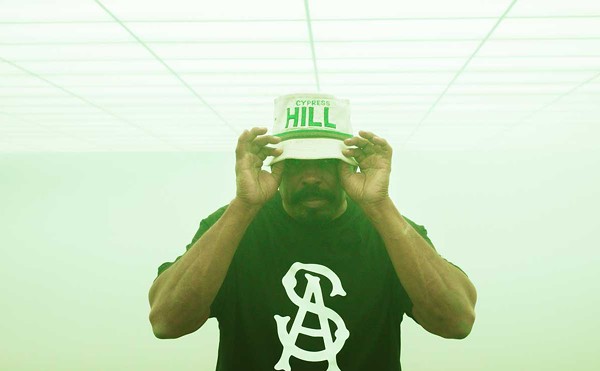It’s a slow midweek summer night at Manhattan’s Westbeth Theater, nestled in the cozy end of tony Greenwich Village. Amid the posters for comedian Margaret Cho’s one-woman show, which usually occupies the theater, Ann Arbor’s Brendan Gillen and Eastpointe’s Brian Jeffries – better known to the electronic music world as Ectomorph and DJ Godfather, respectively – are making their New York debut as part of the weeklong Digital Club Festival.
Though it would seem the Michiganders’ future-funk – a combination of Gillen’s live electro sequencing and effects looping and Godfather’s scratch DJing – would be just the kind of "live" act a festival with "Digital" in its name would go for, the better part of the festival’s badge-holders must be across town trying to catch such traditional "live" fare as the much-hyped club appearance by Brit-grungesters Bush or Public Enemy’s reunion show.
In fact, the handful of curious rock scribes from Spin magazine makes up more than half the audience as Gillen programs his first beat of analog pings and knocks for Godfather to scratch to. While admittedly not "live" in the Prodigy-dry-humping-rock ’n’ roll way some electronic acts attempt to be, Gillen and Jeffries put on a helluva show, riffing endlessly on their binary vernacular of rearranging prerecorded sounds. At the show’s peak, Jeffries answers Gillen’s changing drum patterns with his own mutated syncopation, echoing the beats with snatches of records as Gillen warps the whole concoction with his vintage delay reverb box.
Like minimalist jazz, their show is based on subtle variations on themes. Owing to the beep-and-bleep vocabulary of dance music, the themes are more tonal and percussive than melodic. "It’s totally improvisational," says Gillen.
"Everything is being done on-the-fly, completely, 100 percent live."
But as tonight’s poor turnout shows at least in part, compared with, say, Bush’s buzzing guitars and swaggering frontmen, a sequence still sounds more like something you program than something you play in front of the audience. Whether Gillen’s making up his drum patterns on the spot or hitting "play" on his sequencer, he looks more like a soundman twiddling with knobs than the future of live music. "Well, we’re as live as this music gets," he adds.
No genre wrestles more awkwardly with playing live than electronic music. Acts either try to find a common throbbing denominator with blues-based rock ’n’ roll (such as Moby), say "what the hell" and cross-pollinate sequencers and guitars, and throw in a few breakdancers to cheerlead the whole thing on (Freestylers), or concede to knob-twiddling geekdom (Orbital, Underworld, Green Velvet, Atomic Babies, the Advent, Crystal Method, etc., etc.). These geeks rely on elaborate visuals that usually reduce the "band" to little more than nerd techies turning knobs and fiddling with sequencers like they’re the soundmen for an unseen and, one would presume, more visually thrilling band. Still others, like Detroit’s own Aux 88 and New York’s Space Girl, nobly try to actually play their synthesizers live, with mixed results.
Newer electronic artists are trying, to quote Depeche Mode, to get the balance right, "playing" music that is largely programmed. Though his record, The Narcoleptic Symphony (Caipirinha), explores ambient at its most evocative and netherworldly, New York’s Unit favors proving his case live. The more gear, he says, the better. "It looks cooler," he says, only half-jokingly.
"People play with laptops and it looks boring. Plus, you need the original gear to get the sounds. I’ve tried just using samples, but it doesn’t sound as good."
Though the slow-motion nature of his improvisations can make them seem as spontaneous as a lava lamp, the worst sin, he says, is faking it, miming to a prerecorded DAT.
As Unit bravely puts it, "How are you ever gonna get good without getting up there and fucking up a few times?"
He cites such acts as Kraftwerk and the Chemical Brothers as examples of true electronic showmen who play live – albeit in the live-rearrangement-of-sequences sense of the word. "The Chemical Brothers know how to react to a crowd. They’re flexible enough that they can keep looping a track out and adding stuff to it depending on how the crowd is. It’s that improvisational element that’s so sorely fucking lacking in most electronic music out there," says Unit.
There’s a deeper irony to playing, or perhaps more appropriately, presenting electronic music live, given that it’s music meant to be DJ’d, not played. Interestingly, now that people watch DJs spin records like they used to watch bands play, there’s a whole new genre of performance-DJing. French disco house duo Cassius spices up its spinning with a sampler, as does fellow filter-funker Dmitri From Paris.
Still others, like Windsor’s Richie Hawtin and Chicago-via-Detroit’s Jeff Mills, expand on the minimal, percussive throb of techno by using 909 drum machines to deepen the overall punch of their long, linear sets. Even though the most live thing Hawtin or Mills may do is bring the mix down to a hi-hat’s "ting" only to build the beat back up one element at a time, they widen the DJ’s set of tools from just mixing between records. And the results can be thrilling. So much so, in fact, that Hawtin’s next release (on NovaMute) will be a mix disc documenting his "decks, efx and 909" DJ set.
Still, there’s a part of playing live that will always equate to good old fashioned rock ’n’ roll sound and fury. One newcomer to the electronic music scene who understands and even embraces this is Leonie Laws, vocalist for U.K. punk-junglists Breakbeat Era. Though the dance community thinks of Breakbeat Era as a side project of jungle producer Roni Size, the group could have a life of its own as a real live touring act made up of – gasp! – real live musicians. Laws’ frenetic, gravelly vocals on BE’s debut, Ultra Obscene (XL/1500), are part Björk, part Janis Joplin and inspired by the 35-year-old’s life as a street musician in India and Japan. "I think my vocals bring a level of emotion to this music that it’s never had before," she says.
In fact, Laws’ voice is so prominent that BE – and this is a compliment – doesn’t sound like the forbidding, dark, surgically sampled-together mix usually equated with drum ’n’ bass. "I don’t even think of it as jungle," Laws says. "It’s more like 21st century pop to me."
And pop it is, right down to its in-your-face, not-a-sampler-in-sight live show. "At first Roni (Size) just wanted me to sing to a DAT tape. But I told him I knew way too many great musicians. Plus, I can’t sing to just a tape; I’m not Madonna," she laughs.
But with a phenomenal live show due to tour the states this fall, she damn well could be.





